![]()
![]()
![]()
Use LEFT and RIGHT arrow keys to navigate between flashcards;
Use UP and DOWN arrow keys to flip the card;
H to show hint;
A reads text to speech;
14 Cards in this Set
- Front
- Back

|
Pietro di Domenico da Montepulciano Virgin and Child with Angels 1420 A lot of delicate gilt detailing serves to display the mastery of the artist. The figures and shapes would be quite simple blocks of solid color without all that gold detail, which adds lightness and delicacy. Angels/crown in gold are barely visible, as if they appear on a different plane of existence. |
|
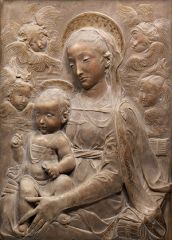
|
Antonio Rossellino Virgin and Child with Angels 1455-1460 Chair is sharply foreshortened, angels are less defined than virgin and child, clearly meant to be in back. Clothing is delicately rendered, obviously fine. |
|
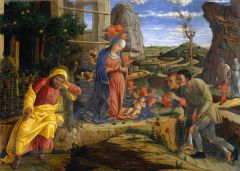
|
Andrea Mantegna Adoration of the Shepherds 1450 Painting is extremely detailed, full of sinuous curves and lines in the landscape. Walled garden and orange trees could refer to annunciation. Madonna's cloak is like a sky, angels burst forth from folds and support child. There's also a humorous aspect in the total grottiness of the shepherds. One has those frickin grody long toenails. What is with that squash and smol cow? Also joseph is asleep. All kind of funny. Characters are detailed because of humanist inclinations of patron. |
|
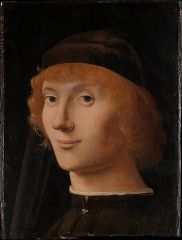
|
Antonello da Messina Portrait of a Young Man 1470 3/4 portrait is a novel format, allows for a more personal relationship with the subject. The boy looks right at us and communicates with us, and his eyes convey an inner life and soul. Background is quite dramatic in contrast to the fair man. |
|
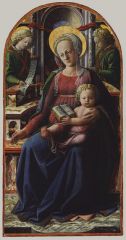
|
Filippo Lippi Madonna and Child Enthroned with Two Angels 1440 Background has perspective, christ child is in an active pose. Halos are like masaccio's, plates in perspective. Veil modeled realistically, vibrant marble. |
|
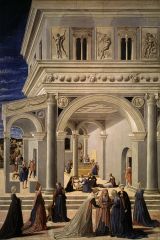
|
Fra Carnevale, Birth of the Virgin, 1467 Set in contemporary location, Palace of Urbino. Italian character is different than Flemish, the virgin is not in the front or a more important place than all the randoms milling about in the foreground. Perspective is 1 pt but seems a little whack? Reliefs derived from Roman Sculpture. |
|

|
Sandro Botticelli The Last Communion of St. Jerome 1490s The branches, crucifix and cardinal's hat on back wall make the space seem like an altar. The small scale and boxlike quality of the walls of his hermit's cell also helps this. St. Jerome receives communion on an altar. |
|
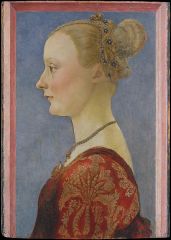
|
Piero del Pollaiuolo Portrait of a Woman 1480 Profile portraits were popular in italy, though they were somewhat less psychological because subject couldn't look at the viewer. This woman is fine and delicate, light colors. |
|
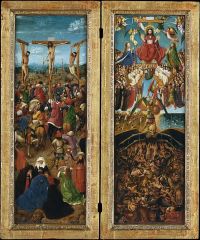
|
Jan Van Eyck, Crucifixion and Last Judgement, 1430 Jesus is on top center in both compositions, but the spaces depicted are wildly different. The crucifixion is orderly, a space set in reality. The Last Judgement is this surreal stacked space, with the strangely scaled heavenly court on top and below this writhing mass of the hellbound. Very detailed. |
|
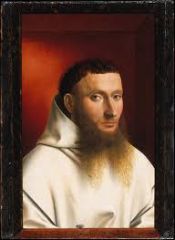
|
Petrus Christus Portrait of a Carthusian Monk 1446 The sitter in this picture communicates with us through the plane, via the inscription on the bottom "Petrus made me in the year 1446" A fly sits on the edge of the frame, a trompe-l'oeil effect. The portrait itself is finely detailed. Warm and alive, and the beard is exquisitely rendered, hair by hair. There's a faint warp in the air around him like a halo. |
|
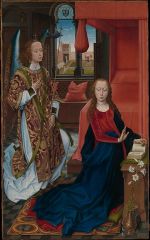
|
Hans Memling The Annunciation 1465-75 Distinctly Flemish, lots of detail, family coat of arms in window, lots of "wink wink nudge nudge" detail. Lillies again. Flemish tastes: Detailed interiors, simple, realistic exteriors. Setting modern, while Italian recalls antiquity. No dynamic perspective, but central figures are clear, much bigger and more detailed. Italians show off architecture legacy, Flemish work concerned with detail and not as much with architectural finesse. |
|
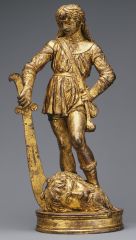
|
Bartolommeo Bellano, David 1470s Smaller table sculpture. Definitely recalls Donatello's, except he is much more modest and slightly more built, less androgynous. Scale of Goliath also larger. |
|
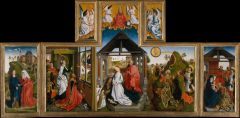
|
Rogier van der Weyden, The Nativity, mid 1400s Overall more austere than Mantegnas, this depicts the whole story surrounding Christ's birth and all the characters in a formal and cinematic mode. Both nativity scenes, but the figures in the Italian one are more realistic in scale and less idealized, which lends some gross humor. The landscape in Mantegnas resembles this Flemish landscape, Mantegnas is more detailed. Figures have more individual personality in mantegnas, humanist style. The Dutch one is more refined, personal vs worship uses are defined. |
|
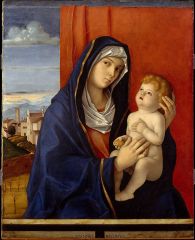
|
Giovanni Bellini Madonna and Child The artist breaks down the barrier between viewer's and pictoral space 3 ways- random curtain being drawn behind madonna sets her apart from the space, creates artificial backdrop parapet with inscription of artist's name madonna looks out at viewer. |

